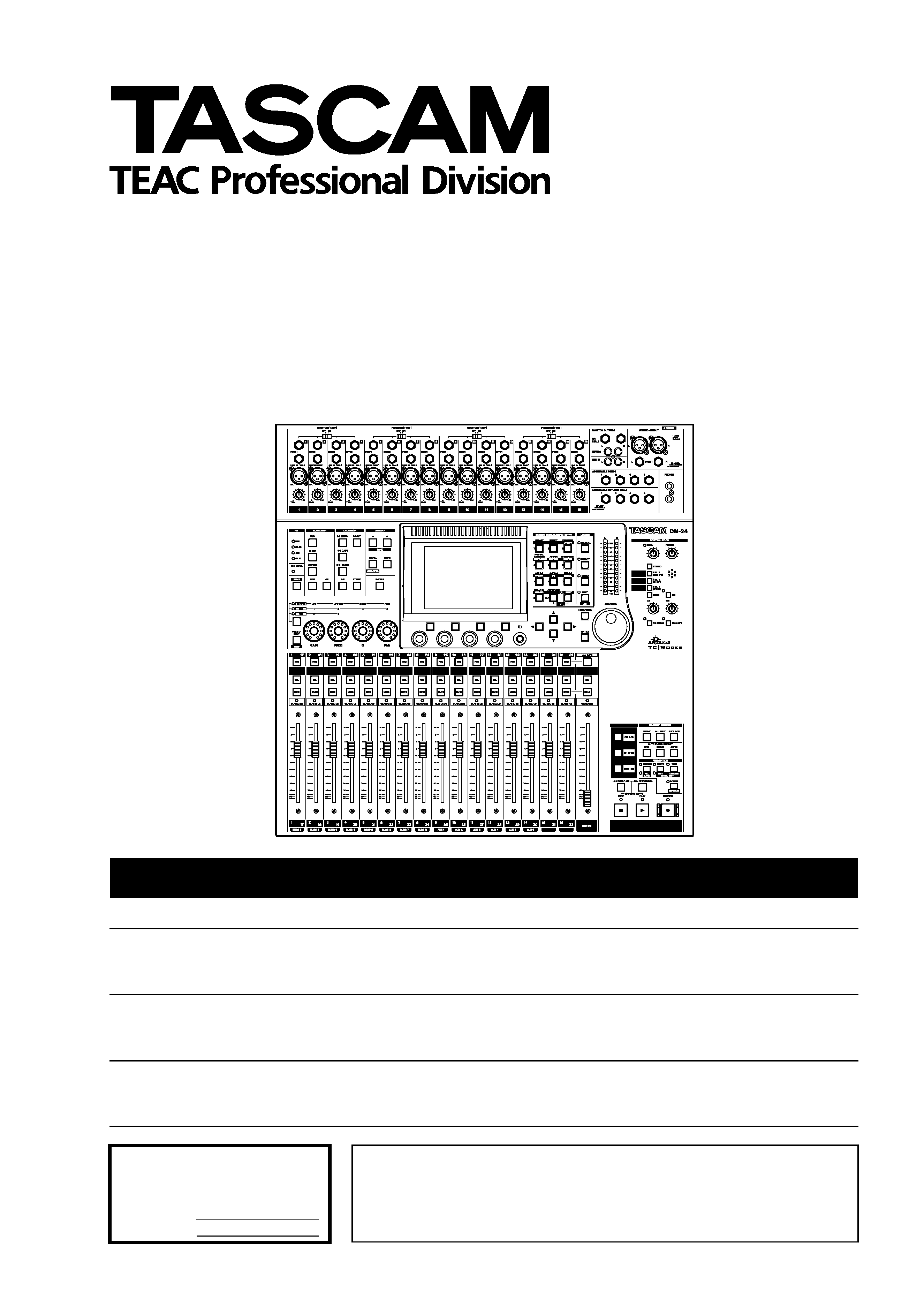
DM-24
Digital Mixing Console
Professional
OWNER'S MANUAL
CAUTION: TO REDUCE THE RISK OF ELECTRIC SHOCK, DO NOT
REMOVE COVER (OR BACK). NO USER-SERVICEABLE PARTS INSIDE.
REFER SERVICING TO QUALIFIED SERVICE PERSONNEL.
The exclamation point within an equilateral triangle is intended to alert the user to the pres-
ence of important operating and maintenance (servicing) instructions in the literature
accompanying the appliance.
The lightning flash with arrowhead symbol, within an equilateral triangle, is intended to alert
the user to the presence of uninsulated "dangerous voltage" within the product's enclosure
that may be of sufficient magnitude to constitute a risk of electric shock to persons.
This appliance has a serial number
located on the rear panel. Please record
the model number and serial number
and retain them for your records.
Model number
Serial number
Ü
ÿ
Y
WARNING: TO PREVENT FIRE OR SHOCK
HAZARD, DO NOT EXPOSE THIS
APPLIANCE TO RAIN OR MOISTURE.
9101439701
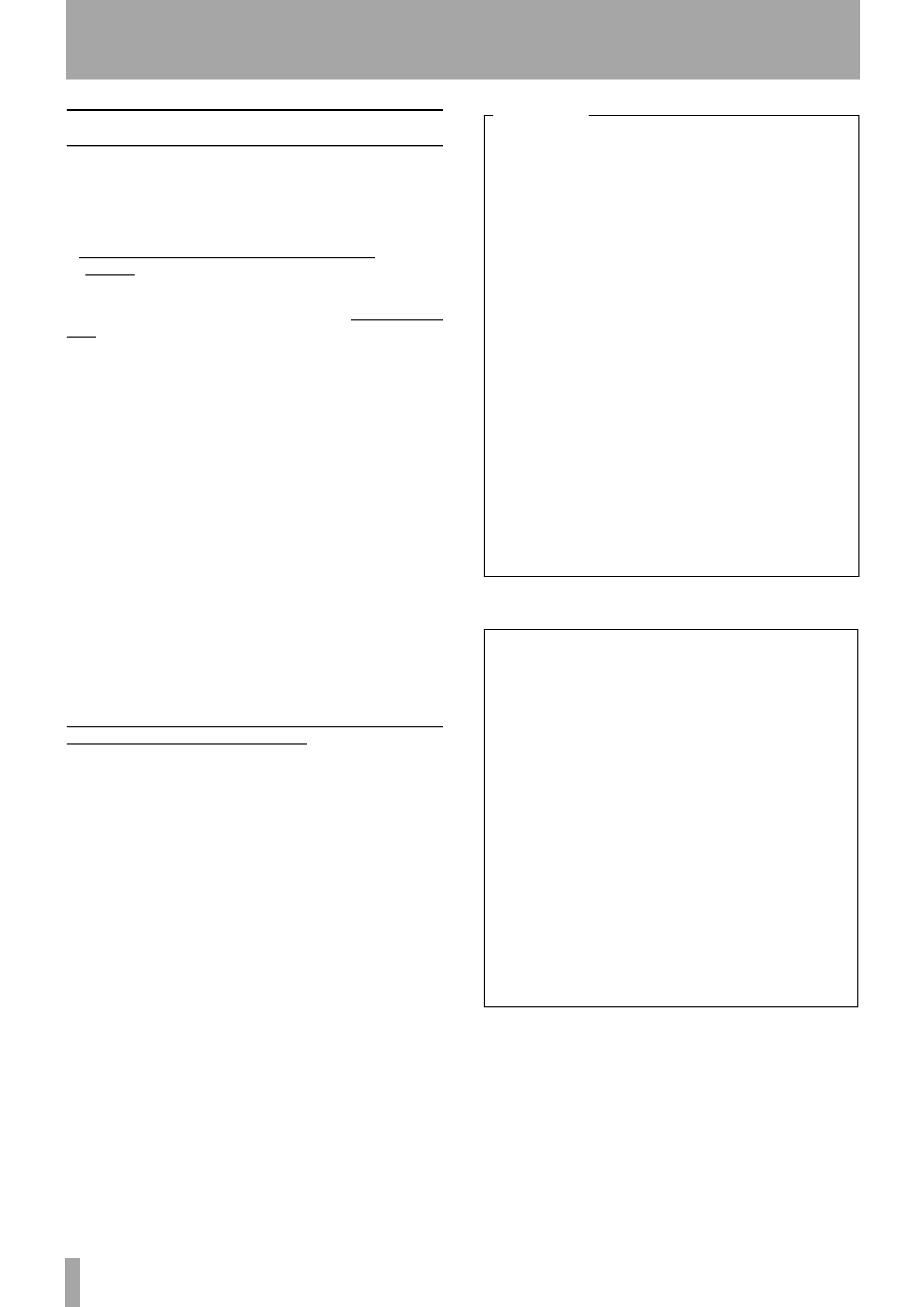
2 TASCAM DM-24
Important Safety Precautions
IMPORTANT (for U.K. Customers)
DO NOT cut off the mains plug from this equipment.
If the plug fitted is not suitable for the power points in your home or
the cable is too short to reach a power point, then obtain an
appropriate safety approved extension lead or consult your dealer.
If nonetheless the mains plug is cut off, remove the fuse and dispose
of the plug immediately, to avoid a possible shock hazard by
inadvertent connection to the mains supply.
If this product is not provided with a mains plug, or one has to be
fitted, then follow the instructions given below:
IMPORTANT: The wires in this mains lead are coloured in
accordance with the following code:
GREEN-AND-YELLOW
: EARTH
BLUE
: NEUTRAL
BROWN
: LIVE
WARNING: This apparatus must be earthen.
As the colours of the wires in the mains lead of this apparatus may
not correspond with the coloured markings identifying the terminals
in your plug proceed as follows:
The wire which is coloured GREEN-and-YELLOW must be
connected to the terminal in the plug which is marked by the letter
E or by the safety earth symbol ç or coloured GREEN or GREEN-
and-YELLOW.
The wire which is coloured BLUE must be connected to the terminal
which is marked with the letter N or coloured BLACK.
The wire which is coloured BROWN must be connected to the
terminal which is marked with the letter L or coloured RED.
When replacing the fuse only a correctly rated approved type should
be used and be sure to re-fit the fuse cover.
IF IN DOUBT -- CONSULT A COMPETENT ELECTRICIAN.
TO THE USER
This equipment has been tested and found to
comply with the limits for a Class A digital device,
pursuant to Part 15 of the FCC Rules. These
limits are designed to provide reasonable
protection against harmful interference in a
residential installation. This equipment gen-
erates, uses, and can radiate radio frequency
ener gy and, if not ins t all ed and used in
accordance with the instruction manual, may
cause harmful interference to radio comm-
unications.
Operation of this equipment in a residential area
is likely to cause harmful interference in which
case the user will be required to correct the
interference at his own expense.
CAUTION
Changes or modifications to this equipment not
expressly approved by TEAC CORPORATION
for compliance could void the user's authority to
operate this equipment.
For the consumers in Europe
WARNING
This is a Class A product. In a domestic environment, this
product may cause radio interference in which case the user
may be required to take adequate measures.
Pour les utilisateurs en Europe
AVERTISSEMENT
Il s'agit d'un produit de Classe A. Dans un environnement
domestique, cet appareil peut provoquer des interférences
radio, dans ce cas l'utilisateur peut être amené à prendre
des mesures appropriées.
Für Kunden in Europa
Warnung
Dies is eine Einrichtung, welche die Funk-Entstörung nach
Klasse A besitzt. Diese Einrichtung kann im Wohnbereich
Funkstörungen versursachen ; in diesem Fall kann vom
Betrieber verlang werden, angemessene Maßnahmen
durchzuführen und dafür aufzukommen.
For U.S.A
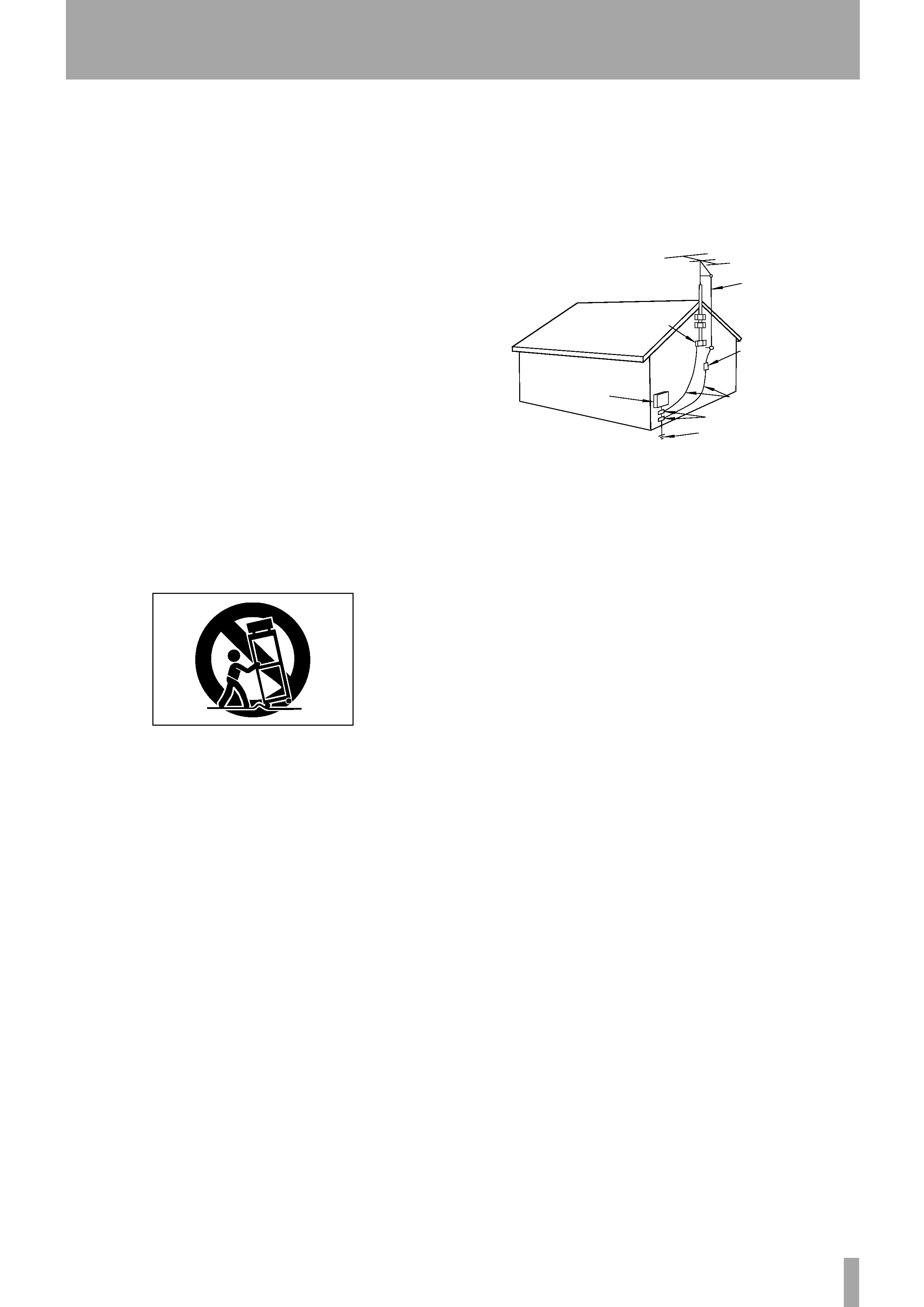
TASCAM DM-24
3
CAUTION:
... Read all of these Instructions.
... Save these Instructions for later use.
... Follow all Warnings and Instructions marked on the audio
equipment.
1) Read Instructions -- All the safety and operating instructions should
be read before the product is operated.
2) Retain Instructions -- The safety and operating instructions should
be retained for future reference.
3) Heed Warnings -- All warnings on the product and in the operating
instructions should be adhered to.
4) Follow Instructions -- All operating and use instructions should be
followed.
5) Cleaning -- Unplug this product from the wall outlet before cleaning.
Do not use liquid cleaners or aerosol cleaners. Use a damp cloth for clean-
ing.
6) Attachments -- Do not use attachments not recommended by the
product manufacturer as they may cause hazards.
7) Water and Moisture -- Do not use this product near water -- for
example, near a bath tub, wash bowl, kitchen sink, or laundry tub; in a wet
basement; or near a swimming pool; and the like.
8) Accessories -- Do not place this product on an unstable cart, stand,
tripod, bracket, or table. The product may fall, causing serious injury to a
child or adult, and serious damage to the product. Use only with a cart,
stand, tripod, bracket, or table recommended by the manufacturer, or sold
with the product. Any mounting of the product should follow the manufac-
turer's instructions, and should use a mounting accessory recommended by
the manufacturer.
9) A product and cart combination should be moved with care. Quick stops,
excessive force, and uneven surfaces may cause the product and cart com-
bination to overturn.
10) Ventilation -- Slots and openings in the cabinet are provided for ven-
tilation and to ensure reliable operation of the product and to protect it from
overheating, and these openings must not be blocked or covered. The open-
ings should never be blocked by placing the product on a bed, sofa, rug, or
other similar surface. This product should not be placed in a built-in instal-
lation such as a bookcase or rack unless proper ventilation is provided or
the manufacturer's instructions have been adhered to.
11) Power Sources -- This product should be operated only from the
type of power source indicated on the marking label. If you are not sure of
the type of power supply to your home, consult your product dealer or local
power company. For products intended to operate from battery power, or
other sources, refer to the operating instructions.
12) Grounding or Polarization -- This product may be equipped with a
polarized alternating-current line plug (a plug having one blade wider than
the other). This plug will fit into the power outlet only one way. This is a
safety feature. If you are unable to insert the plug fully into the outlet, try
reversing the plug. If the plug should still fail to fit, contact your electrician
to replace your obsolete outlet. Do not defeat the safety purpose of the
polarized plug.
13) Power-Cord Protection -- Power-supply cords should be routed so
that they are not likely to be walked on or pinched by items placed upon or
against them, paying particular attention to cords at plugs, convenience
receptacles, and the point where they exit from the product.
14) Outdoor Antenna Grounding -- If an outside antenna or cable
system is connected to the product, be sure the antenna or cable system is
grounded so as to provide some protection against voltage surges and built-
up static charges. Article 810 of the National Electrical Code, ANSI/NFPA
70, provides information with regard to proper grounding of the mast and
supporting structure, grounding of the lead-in wire to an antenna discharge
unit, size of grounding conductors, location of antenna-discharge unit, con-
nection to grounding electrodes, and requirements for the grounding elec-
trode.
"Note to CATV system installer:
This reminder is provided to call the CATV system installer's attention to
Section 820-40 of the NEC which provides guidelines for proper grounding
and, in particular, specifies that the cable ground shall be connected to the
grounding system of the building, as close to the point of cable entry as
practical.
15) Lightning -- For added protection for this product during a lightning
storm, or when it is left unattended and unused for long periods of time,
unplug it from the wall outlet and disconnect the antenna or cable system.
This will prevent damage to the product due to lightning and power-line
surges.
16) Power Lines -- An outside antenna system should not be located in
the vicinity of overhead power lines or other electric light or power circuits,
or where it can fall into such power lines or circuits. When installing an
outside antenna system, extreme care should be taken to keep from touch-
ing such power lines or circuits as contact with them might be fatal.
17) Overloading -- Do not overload wall outlets, extension cords, or
integral convenience receptacles as this can result in risk of fire or electric
shock.
18) Object and Liquid Entry -- Never push objects of any kind into
this product through openings as they may touch dangerous voltage points
or short-out parts that could result in a fire or electric shock. Never spill
liquid of any kind on the product.
19) Servicing -- Do not attempt to service this product yourself as open-
ing or removing covers may expose you to dangerous voltage or other
hazards. Refer all servicing to qualified service personnel.
20) Damage Requiring Service -- Unplug this product from the wall
outlet and refer servicing to qualified service personnel under the following
conditions:
a) when the power-supply cord or plug is damaged.
b) if liquid has been spilled, or objects have fallen into the product.
c) if the product has been exposed to rain or water.
d) if the product does not operate normally by following the operating
instructions. Adjust only those controls that are covered by the operating
instructions as an improper adjustment of other controls may result in
damage and will often require extensive work by a qualified technician to
restore the product to its normal operation.
e) if the product has been dropped or damaged in any way.
f) when the product exhibits a distinct change in performance this
indicates a need for service.
21) Replacement Parts -- When replacement parts are required, be sure
the service technician has used replacement parts specified by the manufac-
turer or have the same characteristics as the original part.
Unauthorized substitutions may result in fire, electric shock, or other
hazards.
22) Safety Check -- Upon completion of any service or repairs to this
product, ask the service technician to perform safety checks to determine
that the product is in proper operating condition.
23) Wall or Ceiling Mounting -- The product should be mounted to a
wall or ceiling only as recommended by the manufacturer.
24) Heat -- The product should be situated away from heat sources such
as radiators, heat registers, stoves, or other products (including amplifiers)
that produce heat.
ANTENNA
LEAD IN
WIRE
ANTENNA
DISCHARGE UNIT
(NEC SECTION 810-20)
G
ROUNDING CONDUCTORS
(NEC SECTION 810-21)
GROUND CLAMPS
POWER SERVICE GROUNDING
ELECTRODE SYSTEM
(NEC ART 250. PART H)
NEC - NATIONAL ELECTRICAL CODE
ELECTRIC
SERVICE
EQUIPMENT
Example of Antenna Grounding as per
National Electrical Code, ANSI/NFPA 70
GROUND
CLAMP
IMPORTANT SAFETY INSTRUCTIONS
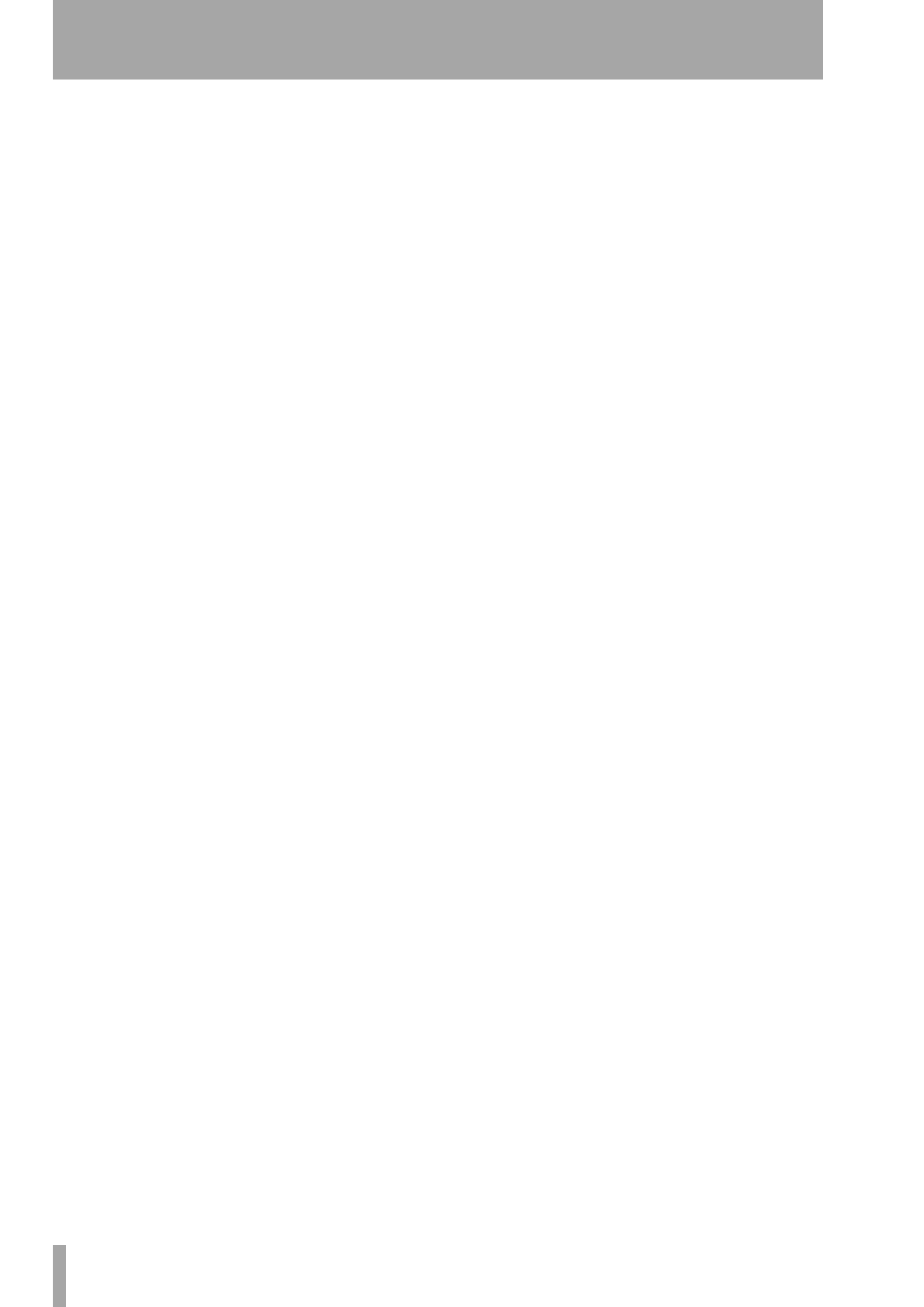
Table of Contents
4 TASCAM DM-24
1 Introduction
Features ........................................................ 8
Supplied accessories .................................... 9
About this manual ....................................... 9
How this manual is arranged ................................. 9
Word clock issues ...................................... 11
2 User interface
Scope of controls ....................................... 12
Global screens ....................................................... 12
Module screens ..................................................... 12
PODs
.................................................................... 13
Fine value settings using the PODs ..................... 13
Other ways of changing values ........................... 14
Using the faders to change values ...................... 14
Soft keys ................................................................ 15
Soft key pull-up menus ......................................... 15
Rotary encoders (ring LEDs) ...................... 15
Encoders used as EQ gain controls ...................... 16
Encoders used as EQ frequency controls ............. 16
Encoders used as Q controls ................................. 16
Encoders used as pan controls ............................. 17
Encoders used as aux send controls .................... 17
Fader layers ................................................ 18
Machine control keys ................................ 18
Automation keys ....................................... 18
Automation status ................................................ 19
3 System-wide options
OPTION screen ........................................... 20
SETUP .................................................................... 20
UPPER BAR DISPLAY ................................................20
LOCATE DISPLAY MODE .........................................20
ENCODER OPERATION MODE .................................20
LIBRARY DIRECT KEY OPERATION ..........................20
OL/STATUS LED TYPE ..............................................20
FADER SENSITIVITY .................................................21
METER CALIBRATION ..............................................21
PREFERENCES ......................................................... 21
Fader Auto MODULE Select ....................................21
Select MODULE Return ...........................................21
ST Link by SEL key ...................................................21
Balance Level CENTER: 0dB .....................................21
SEL Key Follows Fader Layer Status ......................21
Meter Follows SEL key ............................................22
Automation fader OFF ............................................22
Cursor follows EQ Band Key ..................................22
FLASH Info. ..............................................................22
Version Info. ............................................................22
Battery Check ..........................................................22
SOLO
.................................................................... 22
MODE SELECT ..........................................................22
SOLO LINK ................................................................22
SOLO TYPE ...............................................................23
INPLACE SOLO DEFEAT ...........................................23
SYNC/TC ................................................................. 23
DTRS Remote Timecode ..........................................23
RS-422 IN Timecode .................................................23
TRA Target link ........................................................23
Automation synchronization source .....................23
TC IN .........................................................................23
MIDI IN MTC .............................................................24
INT. ...........................................................................24
INT. START TIME ......................................................24
FLY WHEEL (frames) ............................................... 24
DIGITAL screens ..........................................24
CLOCK settings ......................................................24
High sampling frequency ....................................... 25
Fs Status .................................................................. 25
D-IN MANUAL SETUP .............................................. 25
WORD SYNC IN ....................................................... 25
TDIF interfaces ........................................................ 25
ADAT ........................................................................ 25
AES3 ......................................................................... 25
CASCADE MASTER .................................................. 25
Word phase ............................................................. 25
Checking the clock sources ...................................25
Out of range clock signals ....................................26
The FORMAT screen ..............................................26
Type of DIGITAL IN connection .............................. 26
Other digital input parameters .............................. 26
Digital output .......................................................... 26
Multi I/O settings .................................................... 26
Stereo out setup ..................................................... 26
SLOT screen ............................................................27
4 Parts of the DM-24
Top surface .................................................28
Analog module inputs ...........................................29
Other analog I/O ....................................................29
Module control section .........................................30
Library section .......................................................30
Parameter control section .....................................31
Monitoring section ................................................32
Module faders and selection, etc. ........................33
Transport and automation control .......................33
Rear panel ...................................................34
5 Setting up the I/O
Signal sources .............................................36
Sixteen mic/line analog inputs .............................. 36
Three TDIF connectors ............................................ 36
ADAT connector ...................................................... 36
DIGITAL IN 1 & 2 ...................................................... 36
Card slots ................................................................. 36
Assignable returns .................................................. 36
Internal effectors .................................................... 36
Output signals ............................................37
Eight output busses ................................................ 37
Six aux busses ......................................................... 37
Stereo master outputs ............................................ 37
Direct outputs ......................................................... 37
Physical outputs .....................................................37
TDIF-1 connectors ................................................... 37
ADAT OUT connector ............................................. 37
Slot cards ................................................................. 37
Assignable sends .................................................... 37
Digital outputs (x 2) ................................................ 37
STEREO OUTPUTS (L, R) .......................................... 37
Patching between input and return .........37
Assigning inputs to channels ....................38
Input sources ..........................................................38
Return modules .....................................................39
Digital inputs .........................................................39
Channel-to-buss assignments (global) .....40
Master settings ....................................................... 40
AUX 1-2 .................................................................... 40
Channel-to-buss assignments by channel ...........41
Other module parameters ....................................41
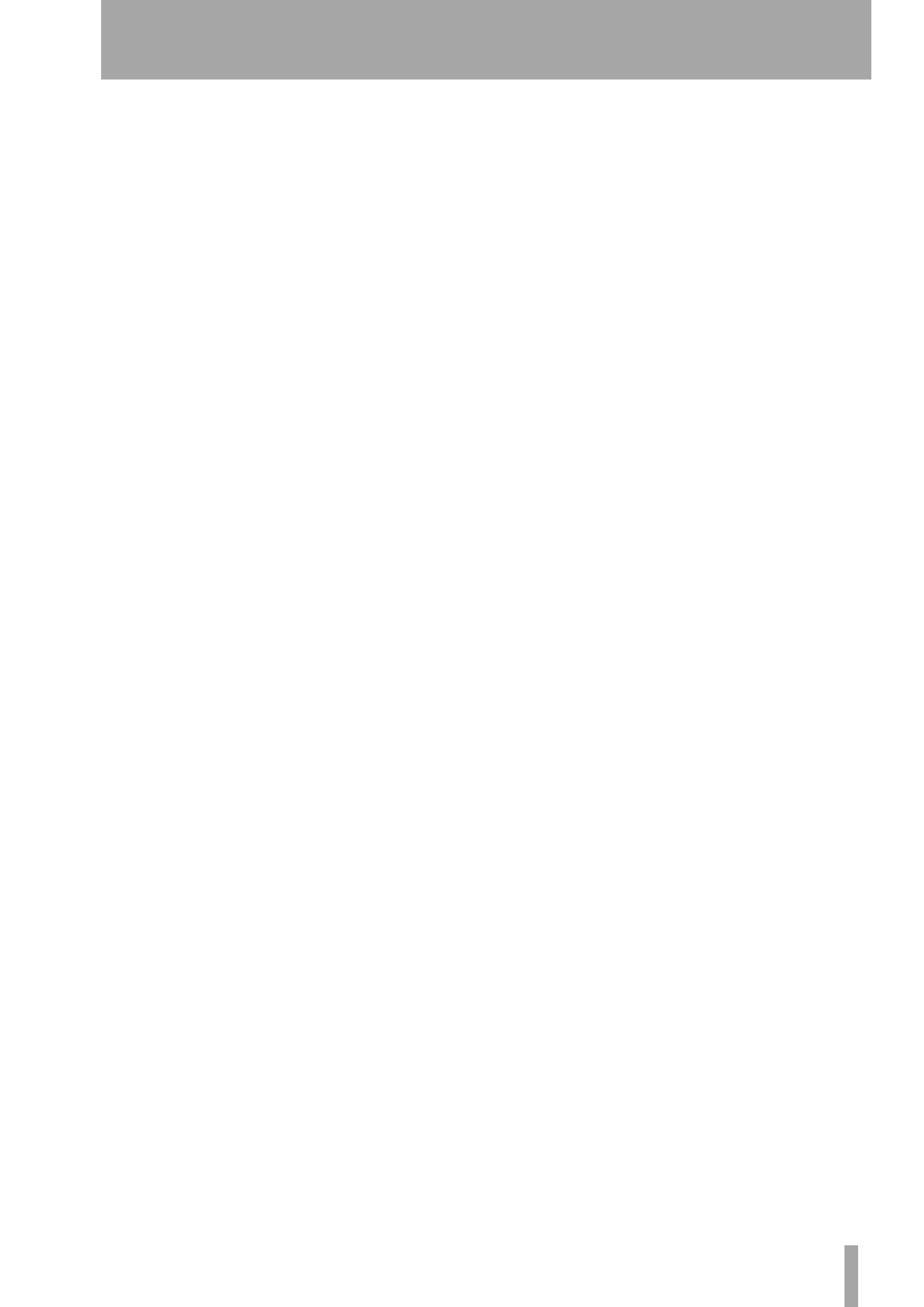
Table of Contents
TASCAM DM-24
5
Output assignments ...................................42
Digital outputs .......................................................42
Assignable sends and returns ...................43
Master compressors ...................................43
6 Hookup
Analog connections ....................................44
MIC/LINE connections ...........................................44
External dynamics processors and effectors .......45
Analog monitoring and mastering ......................45
Digital connections .....................................46
DTRS recorder connections ...................................46
ADAT connections .................................................47
Digital inputs and outputs ....................................47
Synchronization and control connections 47
Word sync clock connections ................................48
MIDI connections ...................................................48
SMPTE/EBU timecode connections .......................48
Meter unit ..............................................................48
P2 connections .......................................................48
7 Module operations
Selecting modules ......................................49
Common area indicators and controls ......50
Dynamics controls .................................................50
Gate/Expander ........................................................ 50
Compressor ............................................................. 50
Compressor insert point ......................................... 50
Dynamics meter ...................................................... 50
Other common controls and displays ..................51
Digital trim and pan ............................................... 51
Phase switch ........................................................... 51
Assignable inserts ................................................... 51
Input/return assignments ...................................... 51
Meter ....................................................................... 51
EQ and buss assignments ...................................... 51
Fader section ........................................................... 51
Mute and fader groups .......................................... 51
Digital trim control ................................................51
Pan control .............................................................51
Balance controls for stereo linked pair ................52
Global pan ..............................................................52
Ganging ................................................................... 52
Setup ....................................................................... 52
Dynamics screen .........................................53
Noise gate (GATE) .................................................53
Compressor ............................................................53
Expander ................................................................53
EQ
............................................................54
On/off (all bands) ................................................... 54
Gain (all bands) ....................................................... 54
Frequency range (all bands) .................................. 54
Q (all bands) ............................................................ 54
EQ band type .......................................................... 54
High band ................................................................ 54
High-mid band ........................................................ 54
Low-mid band ......................................................... 55
Low band ................................................................ 55
EQ library ...............................................................55
Aux sends ....................................................55
Aux sends (global) .................................................55
Fader control ........................................................... 56
Setup ....................................................................... 56
Copy ......................................................................... 56
Source (pre/post and SOURCE) settings ................56
Setup ........................................................................56
Linked aux sends .....................................................56
Setup screen ............................................... 57
Channel source (CH SOURCE) .................................58
Gate switch (GATE SW) ...........................................58
Aux 1 and 2 source (AUX 1-2 SOURCE) ..................58
Compression insert (COMP INSERT) .......................58
Compressor switch (COMP SW) .............................58
Assignable insert position (ASSIGN INSERT) .........58
Assignable insert switch (ASSIGN INS SW) ...........58
Phase switch (
) .....................................................58
Digital delay time (DELAY) .....................................58
Digital delay units (UNIT) .......................................59
Digital trim and delay (global) .................. 59
Global digital trim ................................................ 59
Fader control ...........................................................59
Setup ........................................................................59
Global digital delay .............................................. 59
Unit ...........................................................................60
Fader control ...........................................................60
Setup ........................................................................60
PRE/POST .................................................................60
Linked modules .......................................... 60
Channels ..................................................................60
Master modules .......................................................60
Linking and unlinking modules ........................... 60
Stereo linking (global) .......................................... 61
Screens for linked modules .................................. 61
Phase ........................................................................61
Pan ............................................................................61
Mono switch (MONO SW) ......................................61
UTILITY copying ......................................... 62
8 Dynamics processors
Turning the processors on and off ...................... 63
DYNAMICS (input channels 116) ............. 63
Selecting a gate or an expander ......................... 63
"Master" settings .................................................. 64
GATE/EXPAND .........................................................64
LINK L->R ..................................................................64
Trigger source ..........................................................64
Compressor ..............................................................64
Insert point ..............................................................64
LINK L->R ..................................................................64
Trigger source ..........................................................64
Soft keys (library) ................................................. 64
DYNAMICS (channels 1732) ..................... 64
DYNAMICS (master channels) ................... 65
No expander or gate ...............................................65
Insert point ..............................................................65
Linking .....................................................................65
Assigning processors to master channels ........... 65
Dynamics diagram ..................................... 66
Gates/expanders ........................................ 66
Gate
.................................................................... 66
Threshold .................................................................66
Range .......................................................................66
Hysteresis .................................................................66
Gate attack time ......................................................66
Gate hold time .........................................................66
Gate decay time ......................................................66
Expander ............................................................... 66
Threshold .................................................................66
Ratio .........................................................................66
